April 10, 2007
Turbulence Commission: The Simultaneous Translator
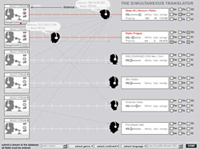
Live Performance on April 15
Turbulence Commission: The Simultaneous Translator by John Roach and Willy Whip [Requires Windows OS] LIVE PERFORMANCE: Sunday April 15; 12:00 PM EST to 3:00 PM EST
The Simultaneous Translator (SimTrans) is a Windows based audio interface that enables anyone to load audio streams and manipulate them in real time on the Internet. SimTrans makes the delays and fluctuations of the Internet visible and audible. The Internet becomes your collaborator as you create your mix, and the instability you usually try to avoid becomes a tool for creation. Distance and delay are manifest within the interface numerically and as a series of sliding heads; there is also a link to Google Earth where you can watch the dynamic flight of data travel between yourself and the audio source.
“SimTrans” is a 2007 commission of New Radio and Performing Arts, Inc., (aka Ether-Ore) for its Turbulence web site. It was made possible with funding from the Murray G. and Beatrice H. Sherman Charitable Trust.
THE PERFORMANCE: The Simultaneous Translator grew out of the artists’ live networked performance project "Simultaneous Translation," in which the delays of the internet are used to dynamically effect the live performances of geographically distant artists.
The performance will take place from 12:00 PM EST to 3:00 PM EST on Sunday April 15. Log on via http://turbulence.org/Works/simtrans.
Participants: Greg Davis (USA), Kenneth Goldsmith (USA), John Hudak (USA), Keyman (France), Lawrence Li (China), Mice69 (France), Miguel Ramos (Spain), Joe Reinsel (USA), John Roach (USA) and Willy Whip (France).
BIOGRAPHIES
JOHN ROACH doesn't consider himself an installation artist, a sound artist, or a sculptor, but prefers to think of himself as a nomad, touching down in whatever place is most hospitable to his ideas. Recent projects have been an installation at the 2B Gallery in Budapest, Hungary; a collaborative performance with objects and video at the Saint Stephen Museum in Szekesfehervar, Hungary; and a web video project called Sweet Music. He continues to work with Willy Whip on their long-standing live networked performance project Simultaneous Translation.
WILLY WHIP is a designer and teacher in hypermedia interactivity. Outside his institutional work he likes to produce mashups that fertilize his own secret garden. This personal research and development leads him on a quest for hybrids: connect this information to that information; grow new contents; release new senses. Recent activity includes projects with the artists Anika Mignotte, Reynald Drouhin, and Du Zhenjun.
Posted by jo at 09:20 AM | Comments (0)
February 27, 2007
Sound Garden
![]()
Telematic Environment for Musical Becoming
Sound Garden: asynchronous improvisation by Norbert Herber + others :: telematic environment for musical becoming & interaction :: Web stream (using iTunes, Real Player, WinAmp, or Windows Media Player) :: Installation: Radio-TV Center (WTIU, WFIU, Department of Telecommunications) IU Bloomington campus.
Sound Garden is the second work in a series of musical installations that explore the relationship of people, location, and audio relative to technology. Listeners use the online interface to tend their sonic environment and take an active role in its composition and care. Using a web browser to select from a menu, participants can contribute their own digital audio files (musical material, voice and environmental recordings, etc.) and become gardeners that help to form the overall sonic landscape of Sound Garden.
Help cultivate the garden with your own short recordings, samples, soundscapes, and found sonic objects. Visit www.x-tet.com/soundgarden and access the web interface to "plant" MP3 files you would like to hear, or "prune" the garden and uproot files planted by others.
Posted by jo at 09:13 AM | Comments (0)
August 07, 2005
THRESHOLDS 31:
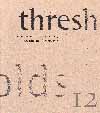
EPHEMERA
Thresholds, the bi-annual critical journal of architecture, art and media culture of the department of architecture at MIT invites submissions for issue 31 'ephemera': DUE: October 31, 2005.
We have accelerated into an age in which information is as fleeting as our response to it, and the capacity for its processing the new world currency. The relevance of the moment has become eclipsed by that of its own passage, and absolute position has become an easy sacrifice for the velocity on offer. We have been at last swept by the flux of our times into a time defined by its own flux. Time has become both the axis and the function.
Thresholds 31 seeks to explore this condition through identifying, suggesting, tracing and questioning the notion of ephemera* through time and cultural relevance. What role does ephemera play within current cultural practice and thought? What are its historical traces and its cultural import? What are the projects in which it has become manifest deliberately, or not and why? Are we longing for a future or a past, or neither?
Contributions from all fields including, but not limited to, scholarly works are welcome. thresholds 31 will be the first issue to accept both text and time-based media submissions. Time-based media submissions might include but are not limited to, video, sound, animation, etc. and will be published in digital format.
*ephemera, n., transf. and fig. One who or something which has a transitory existence. [Oxford English Dictionary, 2nd edition 1989]
SUBMISSIONS
Thresholds invites submissions, including but not limited to scholarly works, from all fields. thresholds attempts to publish only original material. Materials should be postmarked by October 31, 2005.
TEXT: Manuscripts for review should be no more than 2,500 words. Text must be formatted in accordance with The Chicago Manual of Style. Spelling should follow American convention and quotations must be translated into English. All submissions must be submitted electronically, via e-mail or disk, and accompanied by hard copies of text and images. Text should be saved as Microsoft Word or RTF format, while any accompanying images should be sent as TIFF files with a resolution of at least 300 dpi at 8" x 9" print size. Figures should be numbered clearly in the text. Image captions and credits must be included with submissions. It is the responsibility of the author to secure permissions for image use and pay any reproduction fees. A brief author bio must accompany the text.
MEDIA: Media submissions below 8MB can be submitted via e-mail to: thd[at]mit.edu and by disk. Submissions above 8MB must be sent on disk and/or posted on a server for download. Most common file formats will be accepted. Thresholds reserves the right to request reformatting of works for final publication. It is the responsibility of the author to secure permissions for proprietary media use and pay any reproduction fees. A brief author bio must accompany the work.
Please send materials or correspondence to:
Talia Dorsey, Editor
thresholds
MIT Department of Architecture
Room 7-337
77 Massachusetts Ave.
Cambridge, MA 02139, USA
http://architecture.mit.edu/thresholds/
inquiries: thresh[at]mit.edu
text/image submissions: thresh[at]mit.edu
media submissions (below 8MB): thd[at]mit.edu
Posted by jo at 09:15 AM | Comments (0)
February 10, 2005
Seamful Game
![ubicompclient[1].gif](http://www.turbulence.org/blog/images/ubicompclient[1].gif)
Glitches are Integral
Seamful Game, by Matthew Chalmers from the University of Glasgow (Scotland), is a GPS and WiFi based game played in the streets using PDAs. To be successfull, two teams of runners must develop an understanding of the network coverage and the effect of signal strength. It thus turns the patchy network coverage, usually seen as a problem, into an important feature of the game.
Players travel around a designated area collecting digital "coins" (which appear all over the map, including in places not covered by the 802.11b wireless network) and uploading them to get points. To gain these points, players must upload the coin to the server, by pressing the "upload" button on their PDA in an area where there is 802.11b coverage. If players attempt to upload coins in an area not covered by WiFi, the upload fails and they loose all the coins they are carrying. [blogged by Regine on near near future]
Only by understanding the boundaries of the network, and the effect of signal strength on their ability to upload coins, and thus score points, will players be successful in winning the game.
The "Pick Pocket" feature of the game allows a player to steal coins from other players nearby. The player has to be inside network coverage, and use the GPS to get within 10 meters of another player (also within network coverage). By pressing the "Pick Pocket" button, they can grab any coins the victim is carrying but has not uploaded yet.
Plus, scattered around the map are "Mines". If a player moves to within 10 meters of a mine, it will detonate and the player's PDA will be temporarily disabled.
Posted by jo at 09:36 AM | Comments (0)
February 09, 2005
Performance in Plato’s Cave
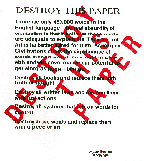
Three Distinct Performances
On Saturday, April 24th, 1999 at 9:24 and 21 seconds, a portion of the Performance in Plato's Cave was transmitted over the internet. In an attempt to follow the Plato’s Cave Performance we have to realize that there are three distinct performances going on simultaneously.
1. The Fake Performance was made to transmit from another location over the Internet in case the equipment failed at the Cleveland Performance Art Festival. The equipment did fail and the fake was transmitted; 2. The Environmental Performance was Alice in Wonderland's tea party adapted to a modern world environment. This also is the Internet Performance; The Non-Performance was a preparation for a conventional performance that would not occur.
To do an Internet Performance you have to get an audience...My goal was to get one viewer...The counter/trackers indicated that at least five people hit the site at the time of the performance.
Posted by jo at 11:43 AM | Comments (0)
January 13, 2005
database

Present Time Always Passing By
database is an electronic reading device that deals with the inversed functionality of three electronic devices: a printer, a video camera and a database. Consequently, it raises issues about the erasure of text, the act of reading in real time (i.e., listening to a printed text), and physical databases. Through the opposition between presence vs. absence, recording vs. erasure, memory vs. forgetfulness, present vs. continuous time and reading vs. listening, we challenge the idea of the database as a non-linear and digital structure, and the printer as an output device as well as an information recorder. Critical for the connection of all these concepts is the idea of present time as a time that is always passing by.
Posted by jo at 08:33 AM | Comments (0)
December 27, 2004
netzwissenschaft
![]()
Emerging Infrastructures of All (Inter)net Research
Dr. Reinhold Grether's network research | netzwissenschaft site maps the "emerging infrastructures of all (inter)net research endeavours. net.science as an anthropology of connectivity is trying to overcome the constraints of specialist method transfers on net matters. the protuberance of technical networks necessitates a professionalization of human net knowledge. neither the isolation of concepts as in basic research nor the encapsulation of processes as in applied sciences will ever be able to adequately describe the complex autopoiesis of networks. net.science is undoubtedly developing into a scienza nuova of its own right."
Check out his Mobile Art and Virtual Performance research areas.
Posted by jo at 04:45 PM | Comments (0)
December 07, 2004
Inexplicable
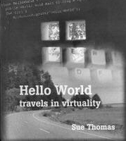
Walter Ong and the problem of writing about LambdaMOO
"I've known Sue Thomas online and off for about 5 years. Her contributions to understanding life online are extraordinary for three reasons. She lives fully online meaning that she immerses herself (not that she lives ONLY online). She takes time to critically and sometimes painfully reflect on her experiences. And most importantly, she shares what she has learned.
Recently she wrote an article for trAce, her online professional (and, I sense, artistic) home. In Walter Ong and the problem of writing about LambdaMOO Sue reflects on why it is so damn hard to explain online interaction experiences to those who have never had one of their own. (Bolding below is mine.)
"At trAce I often speak with people who live and work online about their perceptions of how the net has changed them and the worlds in which they move. In every conversation the transient nature of connectedness is taken so much as a given that there is hardly any need to define or describe it. Everybody knows what it is, how it feels, the energy of it, the occasional despair at its tricks and limitations. We talk about it using the common shorthand of the net - emoticons, acronyms, program code - because the language itself is the key to the concepts and experiences we are discussing. But the problem is that, despite no specific intention that this should happen, it has evolved into a secret cultural discourse which is unintelligible to the uninitiated."
Sue goes on to talk about Walter Ong's work on orality and text based literacy.
"Because Ong’s analysis convinces me that LambdaMOO and places like them are unique in that although their sole method of communication is textual, the communication that actually takes place there is oral. MOO life happens, as Ong describes of a real-life oral community, "as it really comes into being and exists, embedded in the flow of time." Its characteristics are therefore those of a group which shares physical space and human experience, and it is equally fractured and transient. Furthermore, it uses tropes and vocabulary that are also embedded within that experience and unintelligible outside it."
This set off bells for me. I recognized this shift between text created for an article or a novel, and text that "happens" from me as I participate with others online. It is oral. The back channel chat that Liz mentions is an example: how the form allowed the question to surface over the questioner. The question is the story that is passed from teller to teller in pre-literate times. For a moment, it embodies the speaker as he or she experiences typing it into the chat, but through the medium it becomes "of the group." I'm reminded of an article Stowe Boyd wrote recently about "real time," and his experience. "But more important, the idea that there is some high-order benefit in being able to collaborate asynchronously. Its always a crude approximation of real-time interaction, because the players are unavailable."
I can recount experiences for when the asynchronous has created more of a reality than real time. When the players were "available" but in a way I struggle to express. We have different experiences of what Sue called the "embedded flow of time." And for each of us, it is real.
That is what makes this whole experience almost inexplicable. It is experience rather than the reification manifest in text." Originally blogged by Nancy White.
Posted by jo at 11:26 AM | Comments (0)
September 01, 2004
Observing the net
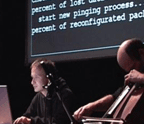
Ping Me a Melody
"Ping Melody is a music-net-performance. Temporary and unique state of all actions of Internet users has an influence on form of music composition. Musician (instrumentalist or singer) is playing on acoustic instrument/singing and sounds coming from instrument/voice are shared in packets of data information (granulated), then transmitted to selected Internet location (as "ping" unix command).
Most of net artists are using some specific possibilities of Internet: they are working with WWW, streaming, etc. In Ping Melody I treat Internet not so much as a tool which functions in given way, but as a space, that can be observed."
Posted by jo at 06:43 PM
August 03, 2004
Lag and Flux as Starting Point
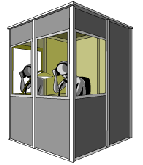
Simultaneous Translation
John Roach is working on a multilocation networked audio performance called Simultaneous Translation which will involve players from USA, Spain, France, Italy and Germany. The first performance is slated for November 2004 in Madrid Spain. Other manifestations are planned for NYC and Trondheim Norway.
"In my first foray into networked performance entitled Negative Space it was the limitations of the streaming media which made the project difficult and exciting. This lag and flux is the starting point of Simultaneous Translation in which the idea of flux and slippage is put in the forefront and is compared to the slippages and mutations of language as it evolves. Another point of comparison is to the delays that occur on the web as data passes from router hop to router hop. In fact traceroute data will be used to manipulate audio streams from the remote participants, making the delay of the internet itself an active player in the project."
Posted by jo at 05:03 PM | Comments (0)
July 30, 2004
Distributed Cinema
SPEC-FLIC
Described by Adriene Jenick as a "Speculative Distributed Cinema Project....a series of fictional events performed as distributed cinema. SPEC-FLIC is a platform for speculation, creative experimentation and imagination among UCSD students, faculty, staff and the larger public. SPEC-FLIC's title refers to speculative fiction (an area of science fiction that is focused less on new science/tech and more on societal impacts) as well as to the size (a "speck") of the PDA-based video frame that serves as the conduit for this durational collective performance. Originally described as a distributed science fiction soap opera in three phases."
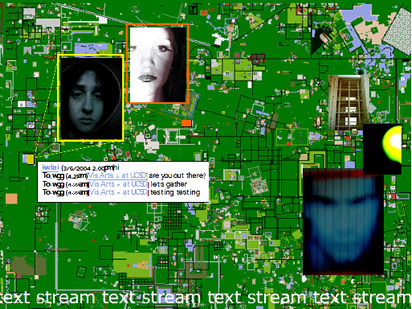
Adriene, tell us about this image.
What is the technology and experience behind this work?
Would you speak about the progression of your work from Paper Tiger television to Desktop Theatre on the internet to Active Campus and Spec Flic on the wireless network?
In your initial post you note these ongoing issues. Can you discuss them by way of examples from your work?
- timing/pacing/duration
this can be thought of from the perspective of participants or from "viewers" - in my experience the "lags" and glitches are all absorbable within the context of a live event. The archiving of this work does not allow for its tension to exist
- relationship of writing to performing, or textuality and orality
this is hugely fascinating to me especially considering the constant evolution of written and spoken language
- use of agitprop to catalyze unexpected engagements
all of my work is engaged within the larger "publc sphere" and cedes a large amount of control to the folks who are engaging with it.
Regarding SPEC-FLIC, your blog shows you in the midst of testing equipment. What are you testing? What is your creative process for working with technology and networks?
Posted by michelle at 09:42 PM | Comments (0)
July 27, 2004
Lag: A Point of View
Today's empyre list (empyre Digest, Vol 18, Issue 14) arrived with a date 1/3/70 and therefore slipped to the bottom my email and probably that of a number of others.
But read it... After Andreas Horbelt’s remarks:
"If somebody stops writing in a textbased surrounding, he stops existing, no matter if he just takes a dramatic pause, if he is laged or if his computer is crashed... In graphical systems, you might still be there (as a visible avatar), but you also might already be gone (if you are lagged or your computer has crashed). So in the end, you're just alive while typing, and every new sentence is a rebirth."
Melinda Rackham, in her empyre post (which is about games) speaks of the Pause or Gap as "our portal into difference" -- a positive take on a similar occurrence. An opening for the unexpected.
Posted by newradio at 01:59 PM | Comments (3)
